February 9, 2015
Rosetta: To Catch a Comet!
Professor Mark McCaughrean
Report by: Andy Sawers
Professor Mark McCaughrean, senior science adviser, European Space Agency
One of the most fascinating space missions of our lifetime was explained in one of the Flamsteed’s most fascinating lectures. Report by Andy Sawers
“Many younger people talked about this being their ‘Apollo moment’,” said Prof Mark McCaughrean as he started his talk on what he described as “one of the most exciting events in decades”.
“That really spoke volumes about the enormous engagement that we managed to achieve with this absolutely thrilling mission.”
Amazing the audience with his ability to pronounce the comet’s proper name, he said that Churyumov–Gerasimenko 67P/C-G is going to “burst into life this year”. Perihelion, its closest approach to the Sun, takes place on August 13 when “we will see a radically different object to the one which we all know so well now,”
Comets capture the public imagination. Comet Hale-Bopp in 1997 was “the last great spectacular of the northern hemisphere”, Mark said. It was visible to the naked eye for 18 months – “Astonishing!”. At about the same time Hale-Bopp was visible, comet Hyakutake was more the sort of “fly by night” event we’re used to, even though it was huge across the sky. But for Hale-Bopp, “Many of us just walked out of the pub and said, ‘Oh it’s there again…’”
“Missions like this inspire children”
Mark expounded a lot on the inspirational significance of the Rosetta mission in terms of its ability to encourage people to turn to science to solve the world’s problems. We are explorers by nature. “As Carl Sagan said, we are originally nomads, so exploration is part of our spirit and that’s why we’re curious about the universe outside the Earth today,” he said.
Obviously, Rosetta had an enormous amount of innovation, not least flying the first ever solar-powered spacecraft out as far as the orbit of Jupiter. The DNA of the European Space Agency spans 20 countries and growing but it couldn’t achieve what it has without cooperation across those 20 member states. “The European Space Agency embodies the spirit of working together – and we would not have been able to do it as individual countries,” Mark said. “And Nasa is a minor partner in this mission, as well.”
While Rosetta was exciting and novel, he said that we have many problems here on Earth: “And we won’t solve them by going to comets. But what we can hope for is that missions like this can inspire children – and people who are children at heart – to become engaged in a way that science can be the solution to the problems that we have on this planet.”
Mark was a professor of astrophysics at the University of Exeter before joining ESA: he said that there was a very significant uptick in the number of students coming to do physics and science because of Brian Cox’s TV series. “They won’t all become space scientists but they will become engaged in what science is as a process for taking on difficult challenges and trying to solve them rationally. There are many audiences I speak to who are excited and enthused and they need to pick up from what we’ve done last year and say ‘We can take on the world in a good way through the methods and the techniques and the technologies – the basic thinking that went into this astonishing mission.’”
Mark pointed out that we are, perhaps, not as clever as we like to think we are. We are merely “clever apes”: “In the last 50 years the one important thing that we’ve learned is that we share an enormous amount of our genetic material with primates. The fact that we have 1% difference in our DNA is what has allowed us to figure out in the last 50 years that it’s only 1%!”
Missions past
Mark ran through some of the tools and missions that are currently helping us observe the universe. “This is where I get to play,” he said of the VLT – the Very Large Telescope comprising four 8-metre telescopes in Paranal, in Chile’s Atacama desert.
The Gaia mission launched in 2014 is mapping a billion stars in the Milky Way, measuring their positions and their motions, “effectively making a movie of the Milky Way, how it’s put together and where it’s going in the future”.
Planck and Herschel studied the cosmic microwave background. Although they are no longer operating they are still returning “an enormous amount” of scientific data.
Mark’s been involved with the James Webb Space Telescope – Hubble’s successor – for many years. It should be launching in 2018.
The point about all these missions is that the universe is “essentially inaccessible”, Mark said. But not totally out of reach. Consider Jack Schmitt on Apollo 17, “the best astronaut who ever went to the Moon – because we was a scientist!” Mark said. “Fighter pilots are great but you want to send a scientist to the Moon.” Schmitt literally carried a geology hammer to the Moon and was able to investigate close up.
Sending humans further than the Moon takes a long, long time, so we send robots. To give a sense of the scale, imagine that the Earth were shrunk by a factor of 100 million to the size of something you can hold in the palm of your hand, then the Moon would be about 4 metres away. On the same scale, at its closest, Mars would be 2 kilometres away. Curiosity Rover – the size of a small car – is driving around on the surface of Mars looking for evidence of water.
“We know there is a million cubic kilometres of ice beneath the surface of Mars today,” Mark said. “Our clever robots can be our proxies to go and do amazing things.” In 2016 ESA will launch ExoMars, a Mars orbiter to be followed in 2018 by a lander which will drill 2 metres below the Martian surface. “If there is life on Mars, it won’t be on the surface. The atmosphere of Mars is so thin that it is sterilised by cosmic radiation,” he said.
Clues in the comets
Why study comets? Comets carry clues about the processes in the formation of the solar system. The first generation of stars formed out of hydrogen and helium, they were massive, they quickly turned supernova, and the fuel they turned into the heavier elements got returned into the universe and they became the next generation of stars. After generations, there would be more of the heavier elements. Five billion years ago – almost 10 billion years after Big Bang – we lived in a galaxy that was full of dense clouds of molecular material and that was full of the heavier elements – carbon, nitrogen, oxygen and so on. These collapsed to form new stars. Around them are disks of gas and dust where planets are born through the agglomeration of material. But at this stage the planets are very hot – too hot for the terrestrial planets to hold any water.
So where did the water come from? “One of the leading hypothesis is that water was delivered later from objects which were left over from the formation of the solar system – asteroids, perhaps, or comets.”
Comets are roughly 50:50 water and dust or pulverised rock and silicates. So are they the origin of the Earth’s water? Comets would also have brought in carbon-rich molecules, in particular the building blocks of life: amino acids. “We know that there are amino acids in comets. So it’s possible that that material is also the building blocks of us – not just the water which we drink,” Mark said.
In 1986, Halley’s comet returned for the first time in the space age. The ESA created the British-built Giotto satellite with the goal of flying past comet Halley. It had to go past at high speed because of the orbits: Halley is on a very elliptical orbit, coming into the inner solar system fast and then going back out and spending a long time in the outer solar system. To match that orbit would have taken an enormous amount of energy from a rocket. Much easier to plan a flypast at 600km distance and a speed of 68km per second.
We knew from analysing their tails that comets must have a huge amount of water in them. “But the great surprise about Halley was that it was black: very, very dark; incredibly so. We weren’t prepared for that,” Mark said.
In 2005, the Deep Impact mission smashed one satellite into the comet Tempel 1 with another trailing behind videoing the results. “But again it was just a fleeting event. There was no long-term study of this comet possible. It happened in one go.”
Finally, comet Hartley 2, studied by the Herschel space telescope, revealed that the isotopic ratios of deuterium and hydrogen in the water seen coming from it was exactly the same as the water on Earth, again raising the question of whether our water comes from comets.
Rosetta’s voyage
With that background, Mark introduced us to Rosetta – a spacecraft whose solar panels give it a wingspan of 32 metres – the same as for an Airbus A320. “It’s a huge spacecraft!” The cube of its body is roughly 2mx2.5x3m, weighing at launch 3 tonnes of which half was propellant. The solar panels had to be so large because, to get up close to the comet and not have to do another fly-by, Rosetta had to go all the way out to the orbit of Jupiter. No other mission has ever gone out that far without using nuclear power. Rosetta used solar panels alone which could operate at low light intensity and low temperature.
Philae weighs about 100kg. While the big focus has been on Philae, the great majority of the high-powered scientific instrumentation is actually on Rosetta – “it’s the big science machine”.
Rosetta was supposed to have launched in 2003 and was originally intended to reach comet Wirtanen – “which would have been easier for everybody to say” – but launch was postponed because of an Ariane rocket failure. The delay was such that a new comet had to be chosen: 67P Churyumov–Gerasimenko, whose orbital period is about 6 and a half years, with an elliptical orbit that takes it just beyond that of Jupiter.
One problem was to get from the (near) circular Earth orbit to the highly elliptical orbit of the comet: “There is not a rocket in the world which can put you on a direct trajectory to meet up with 67P.” Instead, Rosetta launched in 2004, flew past the Earth again a year later and got a gravity-assist, flinging it faster and changing the shape of the orbit. A Mars gravity-assist in 2007 sent Rosetta back to Earth where it picked up speed again, passing asteroid Steins in 2008, passing Earth one last time in 2009, asteroid Lutetia in 2010 then finally settling into deep space hibernation in 2011, for two years and seven months.
When it came time to come out of hibernation, ESA considered waking up Rosetta with no press coverage or publicity of any kind until afterwards. “It was risky – nobody had ever hibernated a spacecraft for so long and then woken it up,” he said. But since a press release was eventually going to have to be issued come what may, the decision was made to engage the public with the first of a series of animated videos: Wake up Rosetta.
“We were trying to reach out to a world audience. This grabbed attention,” Mark said. “It anthropomorphised the characters – which became a problem: parents write heart-breaking emails to us saying ‘Please make another film so I can tell my child that Philae isn’t dead but just sleeping!’”
On 20 January 2014, scientists involved in the mission ran a sweepstake on the time that a successful wake-up signal would be received from Rosetta. The signal arrived almost 20 minutes after the latest sweepstake entry – to the great relief of everyone (even though no one won the sweepstake) – and Rosetta tweeted “Hello, world!”
“This was just the beginning: having a wake-up meant we had a mission, but we were still a long way from the comet,” Mark said. Rosetta had to catch up with the comet, then slow down and allow the comet to catch up.
The floating rubber duck
It was a real surprise to the Rosetta team that 67P was shaped like a rubber duck and also lacked any of the smooth surfaces of Tempel 1, making it difficult to land and even to orbit. “The gravity on this object is different from place to place, so flying close up to it is highly perturbed by the change in gravity,” Mark said.
It wasn’t known whether it was two objects joined together or one object that was highly sculpted. The rough surface isn’t caused by impact craters – in fact only one impact crater has been found. All the sculpting has been caused by activity from beneath the surface of the comet creating holes where material flows out.
At around 4km long, 67P is not a huge comet (click here for an image that compares the size of 67P to London) but it’s not small, either. And it’s not made of rock. It has a density of 470kg per cubic metre – that’s less than half the density of water. “This thing would float very high up in the water if you dropped it into an ocean somewhere.”
There are boulders on the surface but it’s not obvious how they got where they are: could they have fallen down from higher up parts of the comet? “On an object like this, where is ‘down’?” Mark said. “‘Down’ is in very many different places on an object like this.”
One public engagement issue was that it was basically impossible to release a colour photograph of 67P: it is so dark it only reflects about 6% of the light hitting it. “It really is that grey. There is essentially no colour in this comet at all. If there was a lot of surface ice exposed, it would be blue in these pictures, but we only see a few specks. Most of it is covered by the dust which fell back onto the comet last time it came around the Sun.”
In contrast, Saturn’s icy moon Enceladus has an albedo of almost 1, reflecting almost 100% of the light that falls on it. The Earth reflects 30% of the light, and our moon 12%. “We see our moon as white against the dark sky but it’s actually a very dark object,” Mark explained.
The dust on the surface of 67P will get “blasted away” as it gets closer to the Sun, and that’s what makes the tail. But the sunward side of the comet could lose up to 20 metres of surface. “We’ve started naming features on this comet but by the end of the year it may all have changed. It’s not going to be static.”
Philae dares for its freedom
There was a three-month window in which to choose a landing site. The Rosetta team couldn’t wake the spacecraft up until it was close enough to the Sun to get enough power, but if it got much closer to the Sun the activity on 67P would rise to the point where it wouldn’t be possible to operate next to the comet. “That was the window which we had available to get there, take pictures, do science, find a landing site and get down. People worked their backsides off!” Mark said.
A number of potential landing locations were shortlisted and then landing site ‘J’ was chosen – the ‘error circle’ was more than a square kilometre. “There was a lot of concern!” Mark said. On November 12, as Rosetta approached the comet, Philae was released and from that point on it could not be controlled. It was like throwing a dart and hoping to hit the target.
As Philae touched down, harpoons were supposed to fire into the surface up to 2 metres deep to pull the small spacecraft down while ice screws in the feet were to anchor it. But the harpoons didn’t fire and the ice screws couldn’t bite into anything. Philae was propelled back into space.
Mark explained what happened next: “There is a flywheel on board, spinning horizontally to keep it stationary going down to the surface. The second we touched down the flywheel was turned off, but of course it takes some time to slow down. So as we lifted off again, the flywheel then started rotating the spacecraft. The spacecraft was now lazily rotating as it started moving across the surface. One hour later, the spacecraft started tumbling. We’d hit something else. We hit the edge of a cliff. Another hour later we touched down again, we then bounced a few metres for another few minutes – the gravity is very low. And then we came into the location where we finally settled. And now here we are, up against a cliff.”
After landing
Philae has two batteries: the primary battery was to get Philae through the first three days – the primary science phase. A secondary battery was to get recharged by its solar panels, but it needs 17 watts – six hours a day of sunlight at this distance from the Sun. Where it ended up it’s only getting an hour and a half. As we get closer to the Sun, however, the amount of sunlight will increase by a factor of five, which means there should be enough sunlight should work again around May/June.
But Philae hasn’t actually been found yet and there is no certainty that the solar panels are oriented the right way to receive more sunlight. “We’ve stopped looking for Philae for the time being as it’s stopping us doing the real science of the mission,” Mark said. “If Philae wakes itself up it will tell us where it is by radio signals.”
The point of the mission was to do science, of course, not just have an adventure. Rosetta has cameras in the optical, ultraviolet, infrared and millimetre wavelength to study the surface and even below the surface. It gathers gas and dust to be analysed on board in mass spectrometers and it measures the plasma enveloping the comet to see how it interacts with the solar wind. Philae also has instruments on board and even managed to drill around 25cm below the surface, though we don’t yet know if it actually pulled the material up and got it into the “oven”.
And there are sensors that can detect a 0.1 millimetre per second change in the velocity of the spacecraft due to the change in gravity so we can measure the mass of the comet and its internal structure.
Jumping, but not to conclusions
The various geologically distinct areas of the comet have been named and are being analysed. While the gravity on the comet is about 1/100,000th of the gravity on Earth, it depends on exactly where you are because of the comet’s ration: centrifugal force reduces the gravity very significantly – the difference can be a factor of 2. The ‘neck’ might have been thought to have less gravity than the head but as it’s closer to the centre of rotation the gravity is actually higher.
It’s either a great place or a terrible place for “base jumping”, Mark said. It could take you 20 minutes to drop from the top of the comet to the bottom. He got everyone in the audience on their feet and asked them to jump: anyone who jumped more than 4cm high would have achieved 67P’s escape velocity of 0.9 metres/second – and jumped right off the comet!
Back to the question of whether water comes from comets: 67P has the highest deuterium-to-hydrogen ratio ever measured for a comet, and so we can’t simply say that all water comes from comets. “We’ve begun to revise our picture about where the water on the Earth comes from. There are many reasons to believe that comets play a role but not the dominant role in the delivery of our water,” he said.
Ambition
One final question: what happens to Rosetta? If the orbiter is still working, what do we do with it? “We don’t want to go back into hibernation again – that was nail-biting enough the first time. And we won’t have much fuel left. But one thought is to land Rosetta on the comet – so we can have November 12th all over again!”
Finally, at the end of a fascinating, inspiring, 90-minute talk, Mark introduced an extraordinary short film called Ambition that he worked on with a team from Poland. “It’s an allegorical story about this mission – it’s about the philosophy and also it’s cool.”
Concluding, Mark said: “This has been one of the most ambitious space missions in history. We turned science fiction into science fact – and it’s by no means over yet.”
Pictures from the Evening (by Mike Meynell):
Posted under: Flamsteed, Flamsteed Lecture, Meeting Report
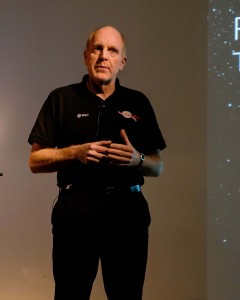
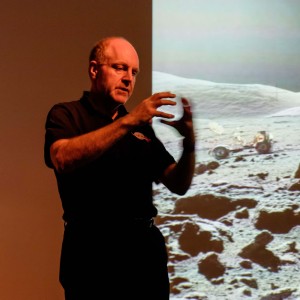
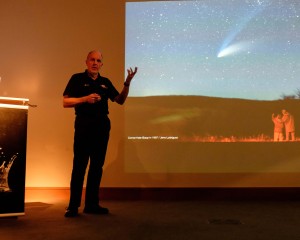
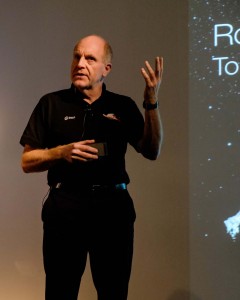
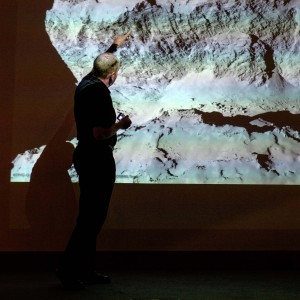






You must be logged in to post a comment.